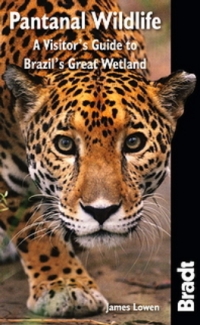Pantanal Wildlife

For those who haven't yet really explored the continent, myself included, you would be forgiven for equating South America with thick jungle. But there is more to this incredible landmass as there is a wide variety other types of habitat, thus I was particularly intrigued to learn about the Pantanal. The author James Lowen's opening statements are evocative: "The Pantanal is to the Americas what the Serengeti is to Africa. If the Amazon forests are South America's lungs, then the Pantanal is the continent's kidneys." Wow, that puts it into perspective.
Spread across three countries — Brazil, Bolivia and Paraguay — and estimated to be between 140,000 and 210,000 km2 in area it is, as the author states, the largest contiguous wetland in the world. It has an amazing diversity of species: some 475 species of birds, 135 mammals, 80 reptiles, 50 amphibians, around 325 fish, countless insects and at least 1,700 plants have been identified so far.
After a stimulating introduction covering the geology, geography, habitats and the human impact on the area, the author has arranged the book into chapters splitting up the mammals, birds and the other taxon groups. Thoughtfully, it is stated quite early on that this is not the definitive identification guide to the wildlife of the area but a general introduction to the types of wildlife that you are most likely to see. It's a wise move as the Pantanal is clearly a huge area and potentially bewildering for any would-be wildlife watcher.
The author treats each chapter with an array of mostly his own photographs that illustrate the particular species in their suitable habitat. You get the impression that what you see in the book is how you are likely to see the species in the wild: for example, a Black Howler Monkey doing what it says on the tin, howling in a tree, or an Anhinga swallowing fish — all doing their natural thing. Each family is treated to a short entry with an explanation of the particular species to be found; helpful identification and habitat tips are also given. It is brief, but that is what this book is all about — an introduction to the fascinating wildlife of the Pantanal.
If I were offer any criticism, then I would comment that some of the photography is a tad dark, making them a bit flat. I am familiar with the author's photography, as he was an ex-pat based in Argentina and supplied a lot of the images for the Neotropical Bird Club. He is an accomplished wildlife photographer, so I presume that some of the darker plates were a printing issue. Overall, I will be packing this book when I make it over to the Pantanal.Pantanal Wildlife by James Lowen, published by Bradt Travel Guides
Softcover. 176 pages, colour photos, maps.
NHBS Price: £16.99. ISBN-13: 9781841623054


